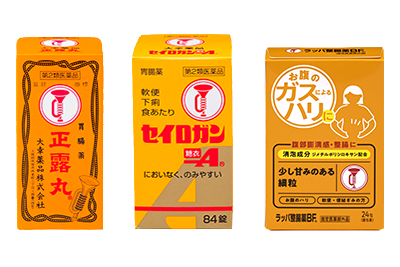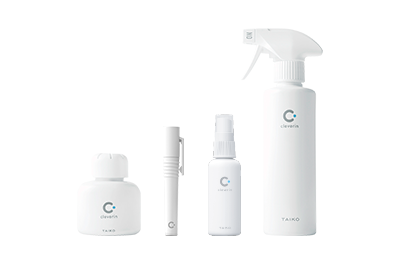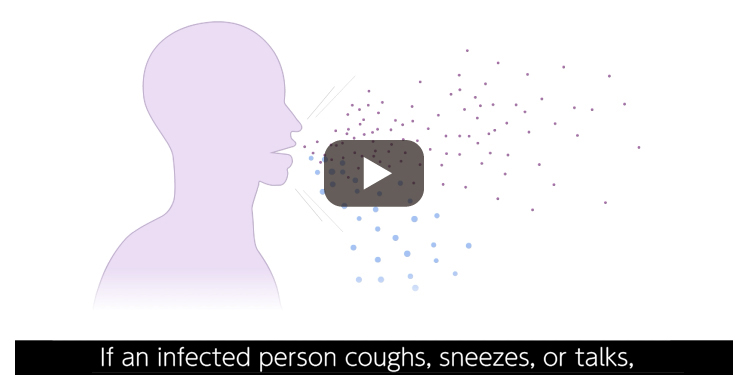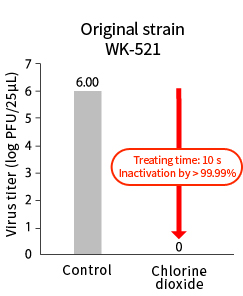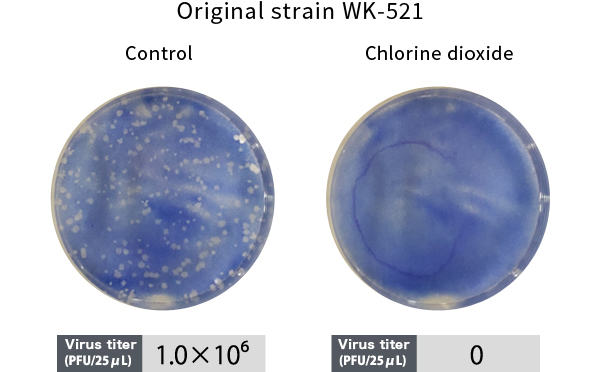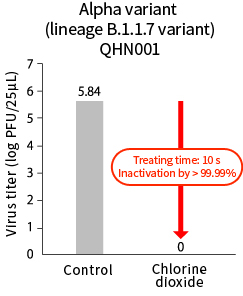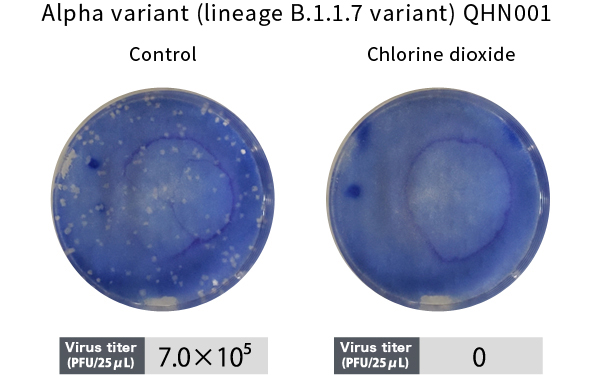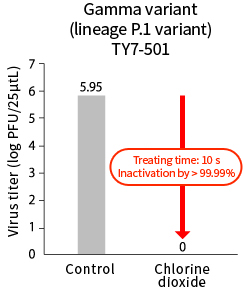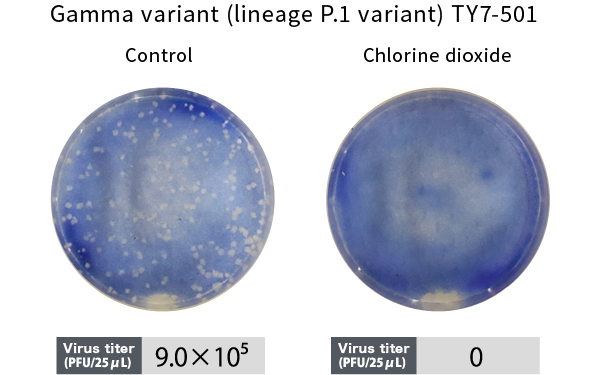Research and Development
Efficacy of Chlorine Dioxide Against Novel Coronavirus (SARS-CoV-2)
Mechanism of Action of Chlorine Dioxide on Novel Coronavirus (SARS-CoV-2)
Methods
Spike protein of the novel coronavirus (SARS-CoV-2, original strain and variants) was mixed with various concentrations of aqueous chlorine dioxide solution to react, following which ACE2 receptor protein was mixed to bind to the spike protein.
Then, horseradish peroxidase (HRP)–labeled anti-ACE2 antibody was added and chemiluminescent of the substrate of the HRP were added.
Next, the chemiluminescence was measured with a luminometer to validate the inhibitory effect of chlorine dioxide against the binding activity of the spike protein of the novel coronavirus (SARS-CoV-2) to ACE2 receptor protein.
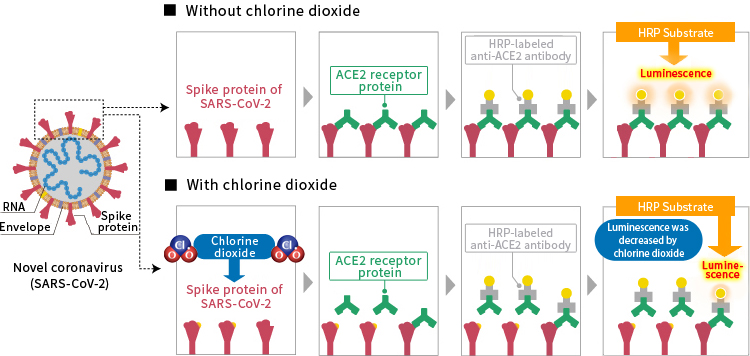
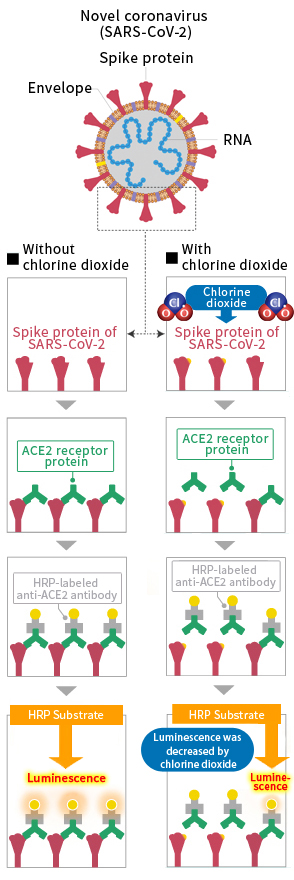
Result
The binding activity (chemiluminescence intensity) of human ACE2 receptor protein to the spike protein of the novel coronavirus (SARS-CoV-2, original strain and variants) decreased with increasing concentrations of chlorine dioxide concentration.
The concentration of aqueous chlorine dioxide solution required to give 50% binding inhibition (IC50) was 6.5 µmol/L (0.4 ppm), 7.6 µmol/L (0.5 ppm) and 5.8 µmol/L (0.4 ppm) for the original strain, the alpha (British) and the beta (South African) variants.
These findings show chlorine dioxide was found to act on the spike protein of the novel coronavirus (SARS-CoV-2) to inhibit the binding to ACE2 receptors.
Effect of Chlorine Dioxide on the Binding of the Spike Protein of
Novel Coronavirus to Human ACE2 Receptors
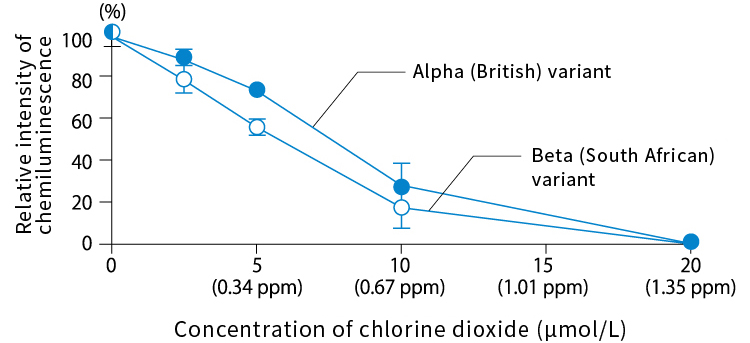
Concentration of Aqueous Chlorine Dioxide Solution Required to Inhibit Binding of Spike Protein of Novel Coronavirus to Human ACE2 Receptors by 50% (IC50)
| Novel coronavirus | IC50 |
|---|---|
| Original (Wuhan) strain | 6.5 μmol/L (0.4 ppm) |
| Alpha (British) variant | 7.6 μmol/L (0.5 ppm) |
| Beta (South African) variant | 5.8 μmol/L (0.4 ppm) |
Ogata N. and Miura T. Ann Pharmacol Pharm 5(5): 1195 (2020).
Ogata N. and Miura T. Ann Pharmacol Pharm 6(1): 1199 (2021).
Mechanism of Action of Chlorine Dioxide on Novel Coronavirus (SARS-CoV-2)
The spike protein on the surface of the novel coronavirus binds to ACE2 receptors on the surface of human epithelial cells to infect humans.
Chlorine dioxide is considered to inhibit novel coronavirus infection by acting on the spike protein of the virus to inhibit the binding to ACE2 receptors.
Ogata N. and Miura T. Ann Pharmacol Pharm 5(5): 1195 (2020).
Ogata N. and Miura T. Ann Pharmacol Pharm 6(1): 1199 (2021).
Inactivation of Novel Coronavirus (SARS-CoV-2) by Chlorine Dioxide
Methods
The novel coronavirus (SARS-CoV-2, JPN/TY-WK-521/2020 strain) was treated with a solution containing various concentrations of chlorine dioxide or sodium hypochlorite for various time and then infected to VeroE6/TMPRSS2 cells to measure the virus infectivity (TCID50/mL).
Distilled water was measured likewise to be compared as control.
[A chlorine dioxide manufactured by Taiko Pharmaceutical Co., Ltd. was used.]
Result
The chlorine dioxide inactivated the virus infectivity of the novel coronavirus (SARS-CoV-2) by 99.96% in 10 s at 8 ppm and almost to below the detection limit in 10 s at 80 ppm (inactivated by >99.99%).
Comparison of Effects on Inactivation of Novel Coronavirus
by Chlorine Dioxide and Sodium Hypochlorite
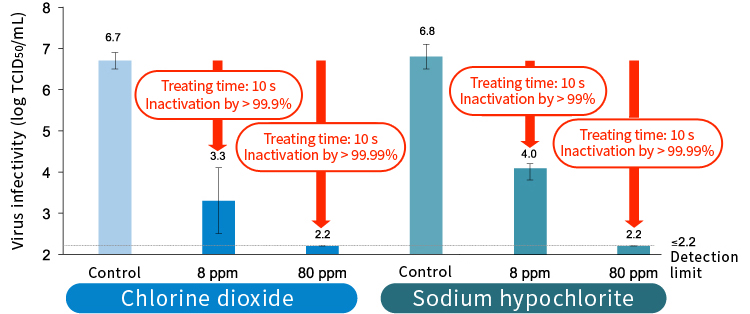
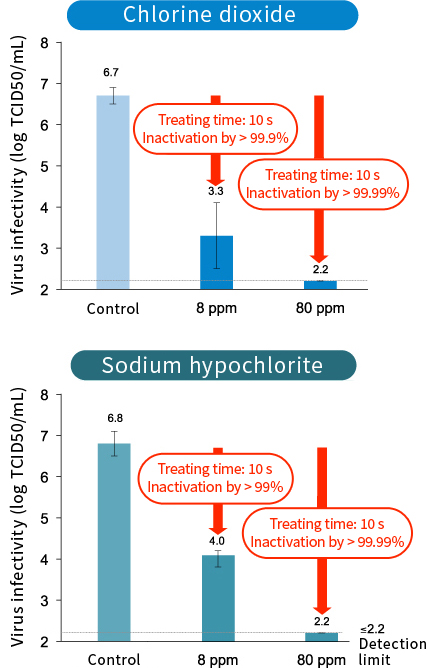
Modified from Hatanaka N., et al. J Hosp Infect 118, 20-26 (2021).
Inactivation of Novel Coronavirus (SARS-CoV-2) Variant by Chlorine Dioxide
Methods
The original strain (JPN/TY-WK-521/2020), alpha variant (lineage B.1.1.7 variant, JPN/QHN001/2020), and gamma variant (lineage P.1 variant, JPN/TY7-501/2021) of the novel coronavirus (SARS-CoV-2) were treated with a solution containing various concentrations of chlorine dioxide for various time and then infected to VeroE6/TMPRSS2 cells to measure the virus infectivity using a plaque technique.
Distilled water was measured likewise to be compared as control.
[The chlorine dioxide manufactured by Taiko Pharmaceutical Co., Ltd. was used at a concentration of 154 ppm]
Novel coronavirus (SARS-CoV-2)
used in the experiment
※The table can be scrolled horizontally.
| Strain name | Formal name | E484K variant (the efficacy of vaccine could be lower than against the original strain) |
N501Y variant (the infectivity could be higher than with the original strain) |
|
|---|---|---|---|---|
| Original strain | WK-521 | hCoV-19/Japan/ TY-WK-521/2020 |
× | × |
| Alpha variant (lineage B.1.1.7 variant) |
QHN001 | hCoV-19/Japan/ QHN001/2020 |
× | ○ |
| Gamma variant (lineage P.1 variant) |
TY7-501 | hCoV-19/Japan/ TY7-501/2021 |
○ | ○ |
Result
The chlorine dioxide (chlorine dioxide concentration: 154 ppm) inactivated the virus infectivity of the original strain (JPN/TY-WK-521/2020), alpha variant (lineage B.1.1.7 variant, JPN/QHN001/2020), and gamma variant (lineage P.1 variant, JPN/TY7-501/2021) of the novel coronavirus (SARS-CoV-2) by >99.99% in 10 s.
Effect of Chlorine Dioxide on Inactivation of Novel Coronavirus Variant
Click to enlarge the image.
Collaborative study between Kitasato University and Taiko Pharmaceutical Co., Ltd.

